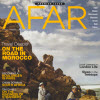ContentWise Blog
By Susan West & Michael Gold on December 14, 2008
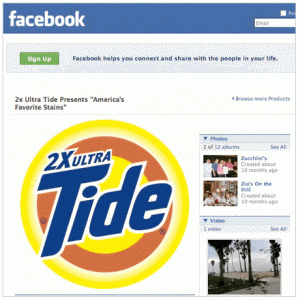 Today’s New York Times Digital Domain column describes the challenges and offers cautionary tales in using social media to promote brands:
Today’s New York Times Digital Domain column describes the challenges and offers cautionary tales in using social media to promote brands:
When major brands place banner advertisements on the side of a member’s home page, they pay inexpensive prices, but the ads receive little attention. Seth Goldstein, co-founder of SocialMedia Networks, an online advertising company, wrote on his Facebook blog that a banner ad “is universally disregarded as irrelevant if it’s not ignored entirely.”
When advertisers invite members to come to pages dedicated to their products, they can attract visitors only by investing in expensive creative material or old-fashioned promotions like prize contests.
The Times report discusses in detail Procter & Gamble’s attempts to use Facebook to promote Tide, Crest Whitestrips, and other products.
Posted in Advertising, Marketing, Social Media
By Susan West & Michael Gold on November 16, 2008
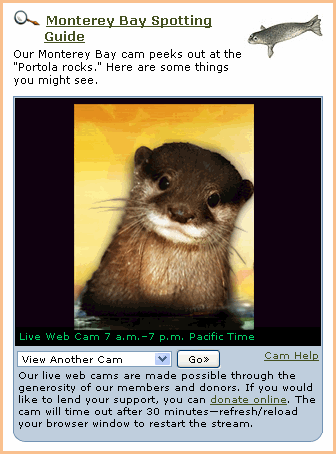 For the next few days we’ll be in sunny Monterey, teaching workshops and directing the Web site critiques at Stanford’s Publishing on the Web conference.
For the next few days we’ll be in sunny Monterey, teaching workshops and directing the Web site critiques at Stanford’s Publishing on the Web conference.
If you’re there too, we looking forward to meeting and working with you. If not, we invite you to tune in to some of the action online:
- Read the combined stream of Twitter messages from conference-goers who are participating in our “team reporting” exercise. As they attend sessions, they’ll post micro-messages that highlight useful factoids, surprising insights, and quotable quotes from conference speakers. If you have a Twitter account, you can add your own comments to the stream by including the label “#pow08” at the beginning or end of your “tweets.”
- Follow the conference’s official Twitter (both during and after the event) for announcements, updates, etc. If you have your own Twitter account, click “follow” while on the workshop’s Twitter page; that will automatically add all official postings from the conference to the updates appearing on your own Twitter page.
- Check out the Web workshop’s social network.
- Get a vicarious version of the killer view here by clicking on the image at right. It will take you to a Web cam run by the Monterey Bay Aquarium. And start making plans to attend this conference next year.
Posted in Conferences & Classes
By Susan West & Michael Gold on November 11, 2008
The International Herald Tribune just published a good roundup of the digital developments that are reshaping book publishing.
Reporter Eric Pfanner starts with Google's recent deal with American authors and publishers allowing the company to sell electronic versions of titles that are out of print. That covers most of the world's books, he points out.
"But the agreement is only one of many initiatives under which books are
making what may be the biggest technological leap since Gutenberg
invented the printing press."
He goes on to survey predictions of digital sales, trends among suppliers and consumers of mobile readers, and digital programs undertaken by European libraries.
Posted in Books
By Susan West & Michael Gold on November 5, 2008
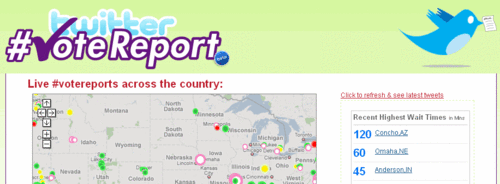 Among the coverage of yesterday’s remarkable presidential election is yet another remarkable application of the microblogging platform Twitter: a sort of nationwide team-based journalism exercise to report on potential problems at polling places.
Among the coverage of yesterday’s remarkable presidential election is yet another remarkable application of the microblogging platform Twitter: a sort of nationwide team-based journalism exercise to report on potential problems at polling places.
The Twitter Vote Report project enlisted a slice of that very large crowd of folks who cast their ballots on Tuesday to monitor moods, wait times, irregularities, and many other indicators of how the voting process went.
Volunteers sent in field reports via their Twitter feeds or by texting on cellphones and other mobile applications. Vote Report invented a few “hash tags” for the occasion to facilitate the concise updates: “#votereport” to tag the message as an official field report, “#good” for no problems, “#wait” to report delays in getting into a booth, “#machine” to signal trouble with voting machines, and so on. (For more details on the hash tags, see Vote Report’s explanation of how to participate.)
Various Web-based tools, some pre-existing and some created just for this project, enabled viewers to tune in to and follow the ups and downs all over the country. It was pretty amazing to watch the national flood of “tweets” in real time.
 At a more local level, here, at right, is what a query for our neighborhood zip code turned up on Twitter Search. (How’d we miss the bake sale?)
At a more local level, here, at right, is what a query for our neighborhood zip code turned up on Twitter Search. (How’d we miss the bake sale?)
Sporadic peeks at Twitter Vote Report yesterday suggested that despite isolated missteps, for the most part the voting went smoothly. We may hear more as folks pore over the streams.
But regardless of what the effort turned up, it’s how the project tackled this reporting job that should interest Web publishers. Once again, social media and crowdsourcing point in some tantalizing directions.
What can your crowd help you report on?
Posted in Blogging, Social Media
By Susan West & Michael Gold on October 27, 2008
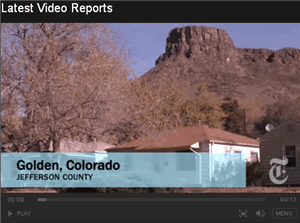 When the New York Times upgrades its whole approach to video, it’s worth noting what’s on the back end. The answer is Brightcove, an online video platform whose name we see more and more next to successful video content on publication-related Web sites.
When the New York Times upgrades its whole approach to video, it’s worth noting what’s on the back end. The answer is Brightcove, an online video platform whose name we see more and more next to successful video content on publication-related Web sites.
Video is an increasingly valuable—and expected—form of content for Web publishers. It’s both an effective way to keep the audience engaged and a promising source of ad revenue. We’ve heard anecdotally that video advertising isn’t shrinking as fast as other online ads.
MediaPost has details on the Times strategy and the capabilities of the Brightcove technology. Tech Crunch covers other Brightcove customers, video viewing stats, and more technical bits.
Posted in Advertising, Newspapers, Video
By Susan West & Michael Gold on October 21, 2008
The appeal of RSS feeds (or Web feeds) still seems limited to a geeky slice of the online audience. Steve Rubel at Micro Persuasion has a succinct analysis of a new Forrester Research report on trends in RSS use.
Some highlights:
RSS adoption among consumers is at 11% up from just 2% of users three years ago…
Here's the kicker, though. That might be all she wrote for RSS' growth track…
Still, while feed adoption may have crested the idea of online
opt-in communications is just getting going. The Facebook newsfeed,
Twitter and Friendfeed are perfect examples of opt-in vehicles that
bring content you care about to you.
Posted in Social Media
By Susan West & Michael Gold on October 13, 2008
Nice to see The New York Times gave some ink this morning to our colleague Scott Karp and his crusade for “link journalism,” a strategy designed to send Web visitors away from your site.
The Times reports that mainstream media sites—including those of the Times itself, The Washington Post, and NBC TV—are starting to embrace the idea.
Scott has long championed link journalism through regular postings on his incisive blog, Publishing 2.0. The basic idea is that you can provide a great service to your audience by filtering and aggregating links to the most interesting and relevant content that is scattered across other sites around the Web.
Many magazines, newspapers, and other nervous Web publishers still question the wisdom of pushing visitors away. Scott offers this one-word rebuttal: Google.
“It’s all about sending people away,” he told the Times, “and it does such a good job of it that people keep coming back for more.”
Posted in Blogging, Magazines, Newspapers
By Susan West & Michael Gold on September 30, 2008
 Wired.com has posted the final entry of its Storyboard blog, which followed the magazine’s design and edit staff through the entire process of producing an article about screenwriter Charlie Kaufman. For magazine wonks—you’re reading this blog, aren’t you?—it’s an irresistible look over the shoulders of a smart creative team.
Wired.com has posted the final entry of its Storyboard blog, which followed the magazine’s design and edit staff through the entire process of producing an article about screenwriter Charlie Kaufman. For magazine wonks—you’re reading this blog, aren’t you?—it’s an irresistible look over the shoulders of a smart creative team.
Playing off the self-referential, Möbius strip-style world of Kaufman’s films (Being John Malkovich, Adaptation, Eternal Sunshine of the Spotless Mind), senior editor Jason Tanz proposed tracking the story’s development online. The blog would be a “profile of a profile.”
Reading Storyboard grunt-by-grunt for a month might have proven a little tedious. We didn’t. But looking over the whole collection of posts now that it’s complete is fascinating.
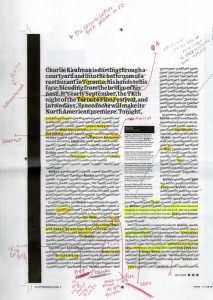 Among the artifacts:
Among the artifacts:
- Video of an early meeting exploring the idea with Tanz, creative director Scott Dadich (who is very into chronicling the creative process at his own design-oriented blog, The Process), senior editor Nancy Miller, design director Wyatt
Mitchell, executive editor Bob Cohn, and editor-in-chief Chris Anderson.
- The pitch memo that Tanz used to get approval of the magazine article. It’s a nice parody of the Kaufmanesque paranoid internal monologue that Nicholas Cage delivered in Adaptation, a vehicle that Tanz rejected as too predictable for writing the actual article.
- Excerpts of e-mail messages about headlines and other display copy
- Written comments on the developing manuscript from editors and fact-checkers
- Design layouts in various stages of evolution.
As interesting as it is to magazine makers and journalists, we can’t help wondering what Wired.com’s main audience made of the Storyboard blog. And did Wired learn anything from this exercise that will shape its publishing plans online, in print, and in the Kaufman-like realm in between?
Posted in Design, Magazines, Multiplatform, Writing & Editing
By Susan West & Michael Gold on September 16, 2008
 The microblogging tool Twitter now has its own television show, sort of.
The microblogging tool Twitter now has its own television show, sort of.
CNN’s wired anchor guy Rick Sanchez is doing a daily newscast (3 p.m. Eastern time, noon Pacific) that features tidbits generated by his audience via Twitter and other social and mobile media. Steve Rubel at MicroPersuasion and Craig Stoltz at Web 2.Oh Really? have the details.
Personally, we’ve got a love/hate thing going with Twitter. By getting users to answer the question “What are you doing,” it pumps more personal grunts and groans into the ever-raging mudslide of mundane musings on the Web. And yet, we’ve found it can be a handy way of glimpsing the activities of family, friends, and colleagues. (Michael’s feed is at http://twitter.com/mgoldsf. Susan’s is dormant at the moment.)
Perhaps more intriguing, people keep trying to use Twitter to commit actual journalism and online marketing, something that all publishers should be exploring. We did a tiny experiment in team Twitter coverage of Stanford’s magazine and book publishing course in June; we’ll try it again more seriously for the upcoming workshop on Web publishing.
Checking Sanchez’s Twitter feed just now we see he has more than 15,000 “followers” and is tracking 13,000 feeds. Say what you will about the quality of his show. It looks like he claimed a big-time presence for CNN in the “Twittersphere” and found a promising new conduit to the audience.
Posted in Blogging, Marketing, Social Media, User-Generated Content
By Susan West & Michael Gold on July 8, 2008
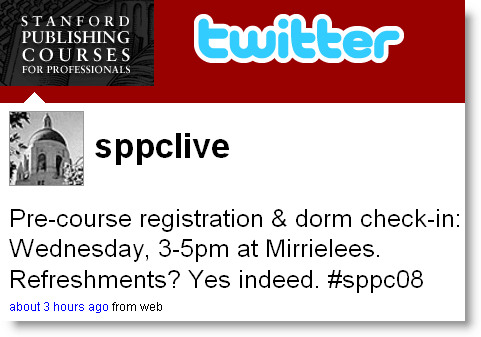 For the next 10 days or so, we’ll have the privilege and the pleasure of teaching at the Stanford Professional Publishing Course.
For the next 10 days or so, we’ll have the privilege and the pleasure of teaching at the Stanford Professional Publishing Course.
What’s not to like? The campus is drop-dead gorgeous. We rub elbows with smart, interesting participants and faculty from all over the world. And at the course climax a week from Saturday, we get to watch the participants pitch their always-amazing ideas for launching hypothetical publishing companies that they will have invented as part of a five-day frenzied exercise.
This year, we thought we’d try adding Twitter to the mix, partly because a number of sessions will focus on moving beyond print and adopting more future-oriented publishing strategies. As an experiment, we’ve established a conference Twitter (sppclive) to serve up housekeeping announcements, schedule changes, reminders, and other bulletins.
Repeat: This is an experiment. Given that we’ll be sneaking in “tweets” around the edges of our official duties, and seeing as how Twitter’s unreliability is legendary, no one who is participating in the course should depend on the sppclive Twitter as the main source of conference information and updates. Still, we hope it will help participants gain a first-hand feel for microblogging, something that everyone in publishing should do.
We’re also going to try talking some participants into helping us “cover” the conference live through an
aggregation of tagged tweets coming from their own, individual Twitter accounts. Tech-oriented conferences are doing this more and more these days. The trick is that correspondents include a conference-specific tag in every posting. Ours will be “#sppc08.”
With any luck, tweets will be flying in from a bunch of conference-goers. And anyone who wants an aggregated, near real-time view of these front-line reports should be able to find it on the appropriate search results page at Summize, a site dedicated to searching tweets.
We’ll report back on all this after the conference. Meanwhile, feel free to tune in.
Posted in Conferences & Classes, Magazines, Multiplatform, Social Media |
 Today’s New York Times Digital Domain column describes the challenges and offers cautionary tales in using social media to promote brands:
Today’s New York Times Digital Domain column describes the challenges and offers cautionary tales in using social media to promote brands: For the next few days we’ll be in sunny Monterey, teaching workshops and directing the Web site critiques at
For the next few days we’ll be in sunny Monterey, teaching workshops and directing the Web site critiques at  Among the coverage of yesterday’s remarkable presidential election is yet another remarkable application of the microblogging platform Twitter: a sort of nationwide team-based journalism exercise to report on potential problems at polling places.
Among the coverage of yesterday’s remarkable presidential election is yet another remarkable application of the microblogging platform Twitter: a sort of nationwide team-based journalism exercise to report on potential problems at polling places. At a more local level, here, at right, is what a query for our neighborhood zip code turned up on
At a more local level, here, at right, is what a query for our neighborhood zip code turned up on  When the New York Times upgrades its whole
When the New York Times upgrades its whole 

 The microblogging tool
The microblogging tool  For the next 10 days or so, we’ll have the privilege and the pleasure of teaching at the
For the next 10 days or so, we’ll have the privilege and the pleasure of teaching at the 